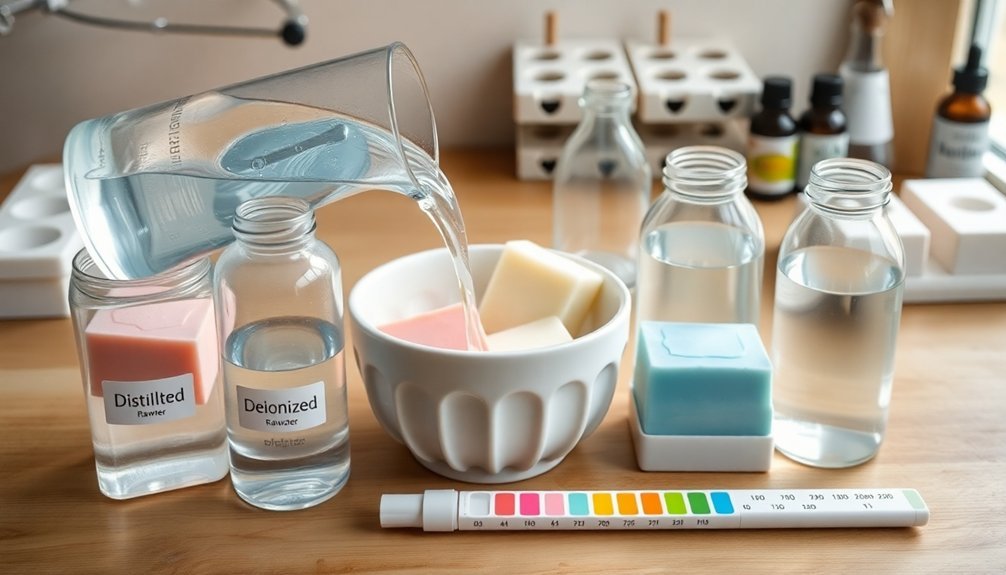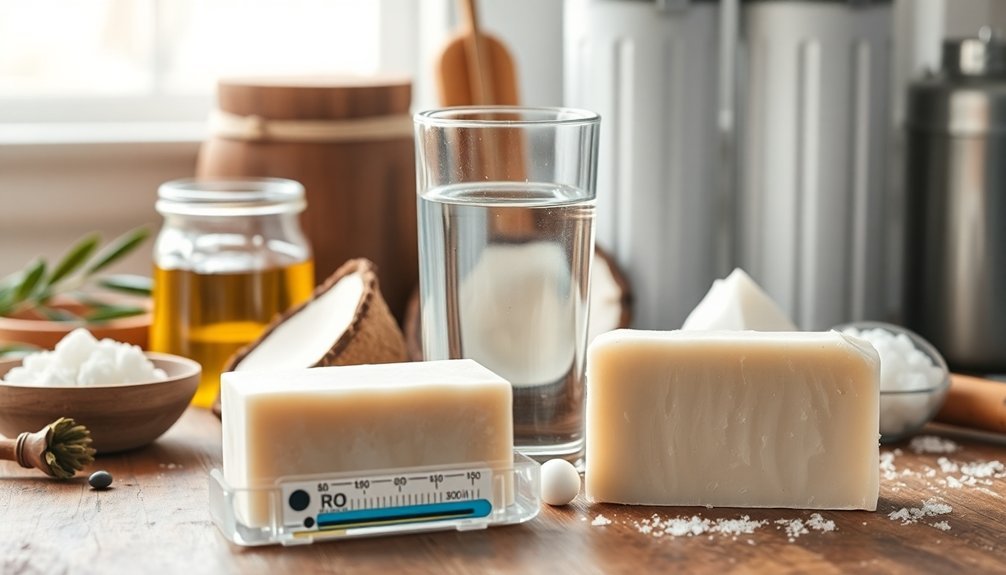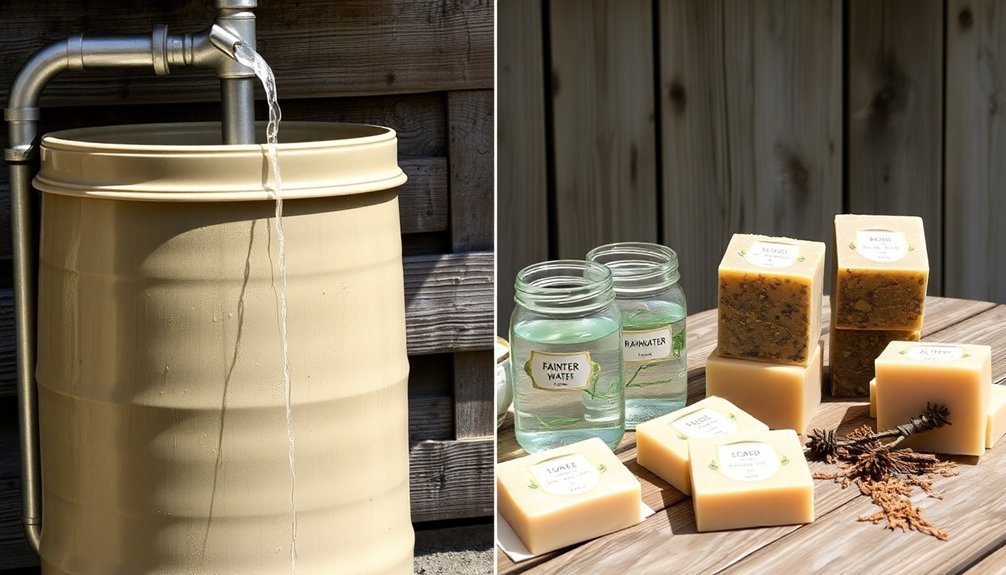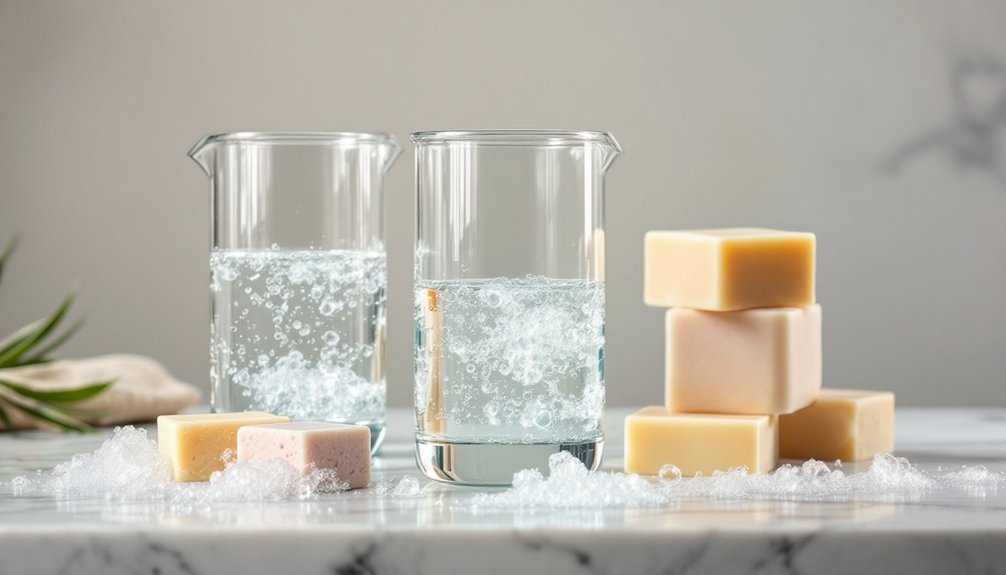For perfect soap making, your best water options include distilled water (ideal for consistent results), reverse osmosis water, filtered water, softened water, rainwater (with proper filtration), and specialty waters like floral hydrosols or milk varieties. Distilled water remains the gold standard, eliminating unwanted minerals that can cause DOS (Dreaded Orange Spots). You'll want to avoid untreated tap water, especially in hard water areas. The right water choice can transform your handcrafted soaps from good to extraordinary.
7 Best Water Types For Perfect Soap Making

Clarity begins with water choice when crafting homemade soap. Distilled water stands as the premier option, ensuring consistency in your batches and preventing unwanted reactions that can compromise quality.
You'll want to avoid tap water, especially if you live in a hard water area where minerals can sabotage your soap's lather and trigger Dreaded Orange Spots.
When mixing your lye solution, remember that proper ratios matter—use at least as much water as lye by weight, with typical ratios ranging from 25% to 40%.
If distilled water isn't available, water from a water softener system offers a decent alternative, as it contains fewer problematic minerals than untreated tap water.
However, for truly professional results, distilled water remains your best investment.
Why Distilled Water Reigns Supreme in Soap Crafting
When it comes to creating perfect homemade soap, distilled water stands in a class of its own. You'll notice immediate improvements in your soap quality when you switch to this purified option for mixing with your caustic soda.
- Consistent results – Distilled water's mineral-free composition guarantees reliable saponification process every time.
- No strange spots – Say goodbye to those mysterious light spots that appear when using tap or reverse osmosis water.
- Extended shelf life – Many soapmakers report markedly fewer Dreaded Orange Spots (DOS) when using distilled water.
- Universal application – Works perfectly for both cold and hot process methods, making it versatile for all your soap crafting needs.
Don't compromise your handcrafted soaps with inferior water – distilled delivers superior results consistently.
Reverse Osmosis Water: Benefits and Potential Pitfalls

Although reverse osmosis water offers a cleaner alternative to tap water, it doesn't quite match the performance of distilled water in soap making.
While it effectively removes many impurities, soap makers have discovered a concerning issue—mysterious lighter colored spots appearing on their soap's surface when using reverse osmosis water.
A revealing experiment in a soap-making studio confirmed this phenomenon: batches made with reverse osmosis water developed strange spotting, while distilled water produced clear, consistent results.
The culprit? Residual minerals that remain after filtration, which can interfere with the saponification process.
You might save money using reverse osmosis water, but for reliable, professional-quality soap, distilled water remains your best choice.
The extra investment prevents unpredictable results and guarantees your handcrafted soaps maintain their intended appearance.
Filtered Water Options for Budget-Conscious Soap Makers
If you're seeking affordable alternatives to distilled water, several filtered options can still produce quality soaps without breaking the bank.
Filtered water removes many impurities found in tap water, making it more reliable for consistent soap batches while reducing the risk of failures.
- Basic carbon filters – These remove chlorine and sediment from tap water, addressing common soap-making concerns.
- Water softeners – Help prevent Dreaded Orange Spots (DOS) and improve lather by reducing water hardness.
- Reverse osmosis systems – Provide highly purified water, though may cause lighter colored spots in finished soaps.
- Pitcher-style filters – Offer an entry-level option that's better than straight tap water.
When choosing filtration methods, consider the initial investment against long-term savings from fewer ruined batches and wasted materials.
Rainwater Collection: An Eco-Friendly Alternative?

While rainwater collection offers an eco-friendly water source for your soap making, you'll need to take into account its variable purity levels which can affect your final product's quality.
Your collection method matters greatly—using food-grade containers with proper filtration systems helps minimize contamination from pollutants, bird droppings, and airborne particles.
Despite these precautions, you're still facing higher contamination risks than with distilled water, potentially leading to inconsistent saponification, reduced lather, and premature soap rancidity.
Purity Considerations
Despite its natural origins, rainwater presents both opportunities and challenges for soap makers seeking eco-friendly alternatives.
When considering rain water for soap making, you'll need to address several purity issues that could affect saponification and soap quality.
- Contaminants – Rain absorbs airborne pollutants as it falls, potentially introducing unwanted chemicals into your soap.
- Variable mineral content – Unlike purified water, rainwater lacks consistency, leading to unpredictable soap results.
- Location factors – Urban areas typically have more polluted rainwater than rural settings.
- Filtration requirements – You'll need proper filtration systems to remove impurities before using rainwater in soap production.
Remember that even though rainwater is renewable, its quality varies greatly.
Testing your collected rainwater before use guarantees it meets the standards needed for successful soap making.
Collection Methods
Proper collection methods can overcome many of the purity challenges mentioned above, making rainwater a viable option for soap makers committed to sustainability. When considering rainwater harvesting versus tap water, you'll need to implement an effective collection system with clean roof catchment, gutters, and storage tanks.
| Collection Component | Purpose | Maintenance Needs | Impact on Soap Quality |
|---|---|---|---|
| Roof Catchment | Initial water collection | Regular cleaning | Prevents contamination |
| Gutters | Water transport | Remove debris regularly | Reduces impurities |
| First-flush diverter | Discards initial runoff | Empty after rainfall | Improves water purity |
| Storage tank | Safe water holding | Clean periodically | Maintains consistency |
Always check local regulations before setting up your system. Using filtered water from rainwater harvesting not only supports sustainability but can produce superior soap quality without the chemicals found in municipal supplies.
Contamination Risks
Although many soap makers are drawn to rainwater for its ecological appeal, considerable contamination risks can't be overlooked.
While it seems like a natural alternative to tap water, collected rainwater often contains hidden pollutants that compromise your soap's quality and safety.
- Environmental contaminants – Rainwater absorbs airborne chemicals and pollutants as it falls, varying considerably by location.
- Microbiological hazards – Harmful microorganisms can thrive in collected rainwater, potentially causing spoilage.
- Inconsistent mineral content – Unlike distilled water, rainwater's composition changes with each rainfall.
- Filtering limitations – Even filtered rainwater retains impurities that may cause discoloration or rancidity.
For consistent, high-quality soap batches that perform reliably, distilled water remains your safest choice despite rainwater's eco-friendly allure.
Understanding Water Hardness and Its Impact on Lather

When you're crafting homemade soap, the type of water you use matters more than you might think.
Water hardness considerably affects your final product's performance and appearance.
Hard water contains high levels of calcium and magnesium that interfere with soap's ability to lather properly. These minerals react with your soap, creating soap scum that reduces cleansing power and leaves residue on skin and surfaces. They can even contribute to Dreaded Orange Spots (DOS) as oils oxidize and turn rancid.
For ideal results, you'll want to use soft water or distilled water in your soap making.
These options contain minimal minerals, allowing for better lather quality, more consistent saponification, and improved overall performance. Your soap will lather more luxuriously and deliver a superior cleansing experience.
Specialty Waters: Floral, Herbal, and Milk Infusions
You'll find that specialty waters, like floral hydrosols, herbal infusions, and milk varieties, dramatically enhance soap quality beyond what regular water provides.
Floral waters add delicate scents and skin-soothing properties, while different milk options (goat, coconut, almond) contribute varying levels of creaminess and nourishment to your soap bars.
Creating effective herbal infusions requires proper herb selection, correct steeping times, and strain techniques to guarantee their beneficial properties transfer into your soap without unwanted plant material.
Floral Water Benefits
Beyond ordinary water choices, floral waters stand out as luxurious additions to your soap-making toolkit.
These botanical infusions, like rose or lavender water, enhance your soap with natural fragrances while preserving the therapeutic properties of the plants. When you incorporate floral waters, you'll need to carefully adjust lye and water ratios to guarantee proper saponification while maximizing benefits.
- Enhanced Skin-Soothing Effects – Floral waters retain beneficial plant properties that calm irritated skin.
- Natural Fragrance Boost – Add subtle, complex scents without synthetic additives.
- Increased Hydration – Create a more luxurious feel that promotes moisture retention.
- Antioxidant Properties – Harness plant compounds that protect and nourish skin cells.
Your handcrafted soaps will gain unique qualities and premium appeal when you replace a portion of distilled water with these specialized botanical waters.
Milk Varieties Comparison
Milk-based soaps represent one of the most luxurious specialty water alternatives in soap making, each variety offering unique benefits for your final product.
Goat milk leads the pack with its exceptional moisturizing properties and creamy texture that creates a rich lather. You'll need to handle it carefully during the saponification process to prevent curdling.
When substituting milk for water, remember to adjust your recipe's water content accordingly. Unlike herbal infusions, milk introduces additional fats and sugars that affect saponification.
Cow milk provides a reliable base, while coconut and almond milks offer vegan alternatives with unique fatty acid profiles.
For best results, freeze your milk before adding lye—this prevents scorching and preserves beneficial properties.
Combining milk with complementary specialty waters can create signature soaps with both moisturizing and therapeutic benefits.
Herbal Infusion Techniques
Specialty waters expand well beyond milk varieties into the aromatic world of herbal and floral infusions.
These botanical enhancements can transform your soaps while maintaining the consistency that distilled water provides. When crafting these specialty blends, you'll need to adjust your lye ratio carefully to guarantee proper saponification.
- Steep dried chamomile or lavender in distilled water to create therapeutic herbal infusions that add natural scent and healing properties.
- Substitute rose or jasmine floral waters for plain distilled water to impart delicate fragrances.
- Incorporate milk infusions like goat milk for luxurious moisturizing, but handle carefully to prevent spoilage.
- Pre-infuse your oils with herbs for deeper colors and aromas while still using distilled water for your lye solution.
Frequently Asked Questions
What Water Is Best for Soap Making?
You'll achieve the best soap results using distilled water, which is free from minerals and contaminants. It prevents issues like spotting and DOS that you might face with tap or reverse osmosis water.
Can I Use Distilled Water in Soap Making?
Yes, you can absolutely use distilled water in soap making. It's actually the preferred choice because it's free from minerals and contaminants that might affect your soap's quality and consistency. You'll get more reliable results.
What Is the Best Water Ratio for Soap Making?
You'll generally want to use 38% of your total oil weight for water. This provides ideal saponification balance, but you can adjust it—less water speeds up the process, more slows it down.
Can I Use Purified Water Instead of Distilled Water?
You can use purified water, but it's not ideal. You'll see lighter spots on your soap compared to distilled water, which gives more consistent results since it's completely free of minerals and contaminants.
In Summary
By choosing the right water for your soap recipes, you'll create superior products with consistent results. Whether you've opted for distilled water's purity, reverse osmosis's balance, or experimented with specialty infusions, your attention to this fundamental ingredient makes all the difference. Don't underestimate water's role in your soap making journey—it's the foundation upon which your creative formulations will truly shine.





Leave a Reply